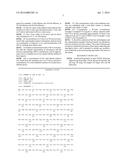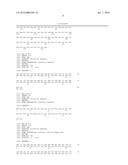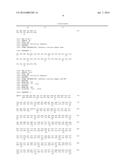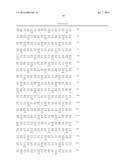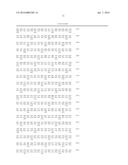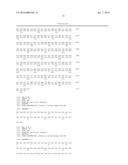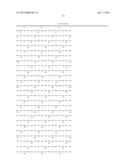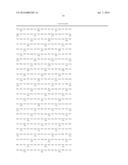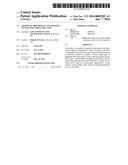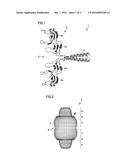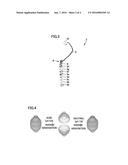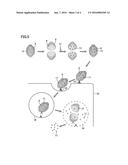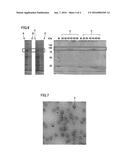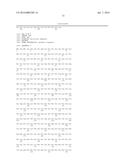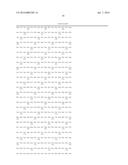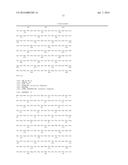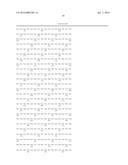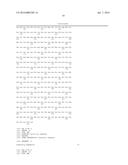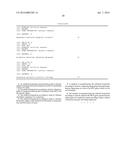Patent application title: ARTIFICIAL BIOPARTICLE AND METHOD OF MANUFACTURING THE SAME
Inventors:
Hideaki Tanaka (Suita-Shi, Osaka, JP)
IPC8 Class: AC07K1447FI
USPC Class:
530350
Class name: Chemistry: natural resins or derivatives; peptides or proteins; lignins or reaction products thereof proteins, i.e., more than 100 amino acid residues
Publication date: 2016-01-07
Patent application number: 20160002305
Abstract:
According to an artificial bioparticle characterized in that a leucine
zipper is integrated in each N terminal of an MVP constituting a waist of
a vault and a method of manufacturing an artificial bioparticle in which
a leucine zipper gene is integrated and expressed in a side to be an N
terminal of an MVP gene, a novel artificial bioparticle including a vault
of which large internal space can effectively be made use of, which can
be used as a nanocapsule applicable to a drug delivery system (DDS), and
a method of manufacturing the same are provided.Claims:
1. An artificial bioparticle characterized in that a leucine zipper is
integrated in each N terminal of an MVP constituting a waist of a vault.
2. The artificial bioparticle according to claim 1, wherein a linker is interposed between the N terminal of the MVP and the leucine zipper.
3. The artificial bioparticle according to claim 2, wherein said linker comprises 3 to 6 glycines.
4. The artificial bioparticle according to claim 1, wherein the leucine zipper is derived from GCN4 which is a transcription activator factor of yeast.
5. A method of manufacturing the artificial bioparticle according to claim 1, comprising integrating and expressing a leucine zipper gene in a side of an MVP gene, which is to be an N terminal.
6. The method of manufacturing the artificial bioparticle according to claim 5, wherein the MVP gene and the leucine zipper gene are coupled by a gene encoding a linker, without a restriction enzyme site being interposed.
Description:
TECHNICAL FIELD
[0001] The present invention relates to a novel artificial bioparticle including a vault, which can be used as a nanocapsule applicable to a drug delivery system (DDS), and a method of manufacturing the same.
BACKGROUND ART
[0002] A vault 2 is a huge ovoid bioparticle having a particle size of 40 nm×40 nm×67 nm, and it is a nucleic acid-protein complex having a largest molecular weight within a cell (see FIG. 2). Vault 2 present in an organism is constituted of three types of proteins (major vault protein (MVP), vault poly(ADP-ribose)polymerase (VPARP), and telomerase-associated protein-1 (TEP1)) and one type of RNA. Vault 2 is such that 39 MVPs 3, which are main components and have a molecular weight of approximately 100 kDa, gather to form a half vault in a shape of a bowl (each site being referred to as a cap 5, a shoulder 6, a body 7, and a waist 8) and two halves are associated at waist 8 as if edges of the bowls were coupled, to thereby form an outer shell of the ovoid particle. Components other than the MVP are present in an internal space formed by the outer shell.
[0003] MVP 3 forming the outer shell of vault 2 is constituted of 12 domains in total including 9 repeating structures (3a, 3b, 3c, 3d, 3e, 3f, 3g, 3h, 3i) formed from antiparallel β sheets and shoulder 6, a cap helix 9, and a cap ring 10 (FIG. 3), and intermolecular hydrophobic bond between domains of cap helix 9 is important for formation of a half vault in a bowl shape. Two half vaults form the ovoid vault particle by associating N terminals of MVPs 3, and such association is formed only based on very weak interaction of ionic bond and a short intermolecular β sheet. Such structural information of the vault and a mechanism of formation of a particle have been clarified as the present inventor succeeded in overall structure determination of a rat liver derived vault in 2009 (see, for example, Hideaki Tanaka et al., "The Structure of Rat Liver Vault at 3.5 Angstrom Resolution," Science, Vol. 323, pp. 384-388 (2009) (NPD 1)).
[0004] It has previously been known that as an MVP which is a main component of a vault is expressed in an insect cell, an ovoid particle the same as in an organism is formed (see, for example, Andrew G. Stephen et al., "Assembly of Vault-like Particles in Insect Cells Expressing Only the Major Vault Protein," The Journal of Biological Chemistry, Vol. 276, No. 26, pp. 23217-23220 (2001) (NPD 2)). Owing to a characteristic shape of a vault, development of a drug delivery system (DDS) by using the vault as a nanocapsule has progressed (see, for example, Valerie A. Kickhoefer et al., "Engineering of vault nanocapsules with enzymatic and fluorescent properties," PNAS, Vol. 102, No. 12, pp. 4348-4352 (2005) (NPD 3) and Valerie A. Kickhoefer et al., "Targeting Vault Nanoparticles to Specific Cell Surface Receptors," ACS nano, 3 (1): 27-36.doi: 10.1021/nn800638x(2009) (NPD 4)).
[0005] For example, Japanese National Patent Publication No. 2013-509202 (PTD 1) has disclosed use of a vault particle which is a recombinant particle having an MVP as well as a fusion protein and mINT and a protein of interest (cytokine) for delivery of the protein of interest to a cell or a tumor, or a target. In addition, for example, Japanese National Patent Publication No. 2007-508846 (PTD 2) has disclosed a technique directed to a composition for delivering a polynucleotide packaged by a polypeptide, having a leucine zipper as a polynucleotide-bound domain.
[0006] In a conventional method, for taking a drug into a particle, a C terminal 160 residue (an INT domain: bonding to an MVP) of a VPARP which is a constituent component of a vault and present in a particle is used as a tag. Such use is also for having the particle retain the drug therein. This method, however, has not yet successfully made full use of a large internal space in the vault.
CITATION LIST
Patent Document
[0007] PTD 1: Japanese National Patent Publication No. 2013-509202
[0008] PTD 2: Japanese National Patent Publication No. 2007-508846
Non Patent Document
[0008]
[0009] NPD 1: Hideaki Tanaka et al., "The Structure of Rat Liver Vault at 3.5 Angstrom Resolution," Science, Vol. 323, pp. 384-388 (2009)
[0010] NPD 2: Andrew G. Stephen et al., "Assembly of Vault-like Particles in Insect Cells Expressing Only the Major Vault Protein," The Journal of Biological Chemistry, Vol. 276, No. 26, pp. 23217-23220 (2001)
[0011] NPD 3: Valerie A. Kickhoefer et al., "Engineering of vault nanocapsules with enzymatic and fluorescent properties," PNAS, Vol. 102, No. 12, pp. 4348-4352 (2005)
[0012] NPD 4: Valerie A. Kickhoefer et al., "Targeting Vault Nanoparticles to Specific Cell Surface Receptors," ACS nano, 3 (1): 27-36.doi: 10.1021/nn800638x(2009)
SUMMARY OF INVENTION
Technical Problem
[0013] The present invention was made to solve the problems above, and an object thereof is to provide a novel artificial bioparticle including a vault of which large internal space can effectively be made use of, which can be used as a nanocapsule applicable to a drug delivery system (DDS), and a method of manufacturing the same.
Solution to Problem
[0014] An artificial bioparticle according to the present invention is characterized in that a leucine zipper is integrated in each N terminal of an MVP constituting a waist of a vault.
[0015] In the artificial bioparticle according to the present invention, preferably, a linker is interposed between the N terminal of the MVP and the leucine zipper. In this case, preferably, the linker includes 3 to 6 glycines.
[0016] In the artificial bioparticle according to the present invention, preferably, the leucine zipper is derived from GCN4 which is a transcription activator factor of yeast.
[0017] The present invention also provides a method of manufacturing the artificial bioparticle according to the present invention described above, which includes integrating and expressing a leucine zipper gene in a side of an MVP gene, which is to be an N terminal.
[0018] In the method of manufacturing the artificial bioparticle according to the present invention, the MVP gene and the leucine zipper gene are coupled by a gene encoding a linker, without a restriction enzyme site being interposed.
Advantageous Effects of Invention
[0019] According to the method of manufacturing an artificial bioparticle in the present invention, an artificial bioparticle can be obtained at yields remarkably higher than in a conventional example. The artificial bioparticle according to the present invention is expected as a nanocapsule which can be used for a DDS and of which internal space can effectively be made use of, and according to the present invention, yields are higher by an order of magnitude, which leads to significant reduction in cost. Based on the artificial bioparticle according to the present invention, progress in development of a particle of which opening and closing can reversibly be controlled depending on pH can be expected.
BRIEF DESCRIPTION OF DRAWINGS
[0020] FIG. 1 is a schematic diagram conceptually showing bond between an N terminal 3a of an MVP 3 constituting a vault 2 and a leucine zipper 4 in an artificial bioparticle 1 according to the present invention.
[0021] FIG. 2 is a diagram schematically showing vault 2 used for artificial bioparticle 1 according to the present invention.
[0022] FIG. 3 is a diagram schematically showing MVP 3 constituting vault 2.
[0023] FIG. 4 is a diagram schematically showing application of artificial bioparticle 1 according to the present invention as a nanocapsule.
[0024] FIG. 5 is a diagram schematically showing one example of a drug delivery system in which artificial bioparticle 1 according to the present invention is applied as a nanocapsule.
[0025] FIG. 6 shows on the left, a photograph showing results of SDS-PAGE after disruption and showings a supernatant (a lane A) and a precipitate (a lane B) of LZMVP_Gly3 and a supernatant (a lane C) and a precipitate (a lane D) of LZMVP_Gly6, and shows on the right, a photograph showing results of SDS-PAGE after sucrose density gradient centrifugation, in which a group a on the left shows results of LZMVP_Gly3 and a group b on the right shows results of LZMVP_Gly6.
[0026] FIG. 7 shows an electron micrograph showing a final purified preparation of LZMVP_Gly3.
DESCRIPTION OF EMBODIMENTS
[0027] FIG. 1 is a schematic diagram conceptually showing bond between an N terminal 3a of MVP 3 constituting vault 2 and leucine zipper 4 in an artificial bioparticle 1 according to the present invention. FIG. 2 is a diagram schematically showing vault 2 used for artificial bioparticle 1 according to the present invention and FIG. 3 is a diagram schematically showing MVP 3 constituting vault 2. As described above, vault 2 is such that 39 MVPs 3 representing main components gather to form a half vault in a shape of a bowl (each site being referred to as cap 5, shoulder 6, body 7, and waist 8) and two halves are associated at waist 8 as if edges of the bowls were coupled, to thereby form an outer shell of the ovoid particle (FIG. 2). MVP 3 forming the outer shell of vault 2 is constituted of 12 domains in total including 9 repeating structures (3a, 3b, 3c, 3d, 3e, 3f, 3g, 3h, 3i) formed from antiparallel 13 sheets and shoulder 6, cap helix 9, and cap ring 10 (FIG. 3). Artificial bioparticle 1 according to the present invention is characterized in that leucine zipper 4 is integrated in each N terminal of MVP 3 constituting waist 8 of vault 2.
[0028] In artificial bioparticle 1 according to the present invention, a linker is preferably interposed between the N terminal of MVP 3 and leucine zipper 4. As such a linker is interposed, a degree of freedom of movement of leucine zipper 4 in artificial bioparticle 1 is ensured.
[0029] The linker between the N terminal of MVP 3 and leucine zipper 4 in artificial bioparticle 1 according to the present invention is preferably formed from 1 to 6 small amino acid(s) aligned in a straight chain. Though artificial bioparticle 1 having leucine zipper 4 is expressed in any case of 1 to 6 amino acids forming the linker, from a point of view of uniformity in obtained artificial bioparticles 1 and a greater amount of expression and from a point of view of a degree of freedom of movement of leucine zipper 4, the linker is preferably formed from 3 to 6 small amino acids as aligned in a straight chain. The amino acid constituting the linker is exemplified by an amino acid having a small side chain such as glycine or alanine. In a present experimental example which will be described later, an example in which a linker is formed from 3 or 6 straight-chain glycines is shown.
[0030] Leucine zipper 4 is a motif like a zipper formed in such a manner that two α-helices each composed of approximately 30 amino acid residues establish hydrophobic bond at leucine residues thereof. For leucine zipper 4 in the present invention, for example, a leucine zipper derived from GCN4 which is a transcription activator factor of yeast or other leucine zippers derived from other proteins can be used without particularly being restricted. Among those, an X-ray crystal structure of a leucine zipper derived from GCN4 which is a transcription activator factor of yeast was determined in 1991 at 1.8 Å resolution, and it was clarified on an atomic level that peptides each constituted of 33 amino acid residues establish hydrophobic bond at leucine residues thereof to thereby form a strong coiled coil. Therefore, a leucine zipper derived from GCN4 which is a transcription activator factor of yeast can suitably be employed.
[0031] Such an artificial bioparticle according to the present invention is expected as a nanocapsule of which internal space can effectively be made use of and which can be made use of for a DDS, and according to the present invention, yields are higher by an order of magnitude, which leads to significant reduction in cost. Based on the artificial bioparticle according to the present invention, progress of development of a particle of which opening and closing can reversibly be controlled depending on pH can be expected.
[0032] Here, FIG. 4 is a diagram schematically showing application of artificial bioparticle 1 according to the present invention as a nanocapsule and FIG. 5 is a diagram schematically showing one example of a DDS in which artificial bioparticle 1 according to the present invention is applied as a nanocapsule. According to artificial bioparticle 1 in the present invention, for example, by introducing a cysteine residue in a leucine zipper attached to an N terminal of an MVP, as shown in FIG. 4, a nanocapsule of which opening and closing can reversibly be controlled depending on pH in such a manner that a stable ovoid particle is formed based on disulfide bond under a neutral condition and the particle opens as if an egg were just split into two as a result of cleavage of disulfide bond under an acid condition can be developed. By using such a nanocapsule, for example, as shown in FIG. 5, such a DDS is also possible that a drug 11 is placed in an internal space of vault 2 under the acid condition followed by administration so that the nanocapsule is taken into a target cell 13 as a result of an antigen-antibody reaction between a specific antigen 12 on a surface of target cell 13 and an antibody (Fab) attached in advance to the surface of vault 2, the nanocapsule opens as an acid condition is established in endosome 14, and drug 11 is released. Such an artificial bioparticle according to the present invention has a very large space therein, and hence it is considered to be viable as a carrier in a gene therapy.
[0033] In addition, use of artificial bioparticle 1 according to the present invention as a nanocapsule in which cosmetic components are confined for permeation deep into skin is also possible.
[0034] Recently, such a technique has also been established that an internal space of a protein complex is used as a template, a metal is polymerized, and the polymerized product is regularly sequenced so that a substrate serving as a base for an extremely small semiconductor. Though a spherical protein such as ferritin is currently used, by using an oval particle like vault 2 by making use of artificial bioparticle 1 according to the present invention, a novel, unprecedented substrate may be made.
[0035] The present invention also provides a method of manufacturing artificial bioparticle 1 characterized in that a leucine zipper gene is integrated and expressed in a side of an MVP gene, which is to be an N terminal. Thus, as will be described later in the experimental example, artificial bioparticle 1 according to the present invention can be obtained at yields significantly higher than, or at least 10 times as high as, in a conventional expression system in which an insect cell having a W-vault formed of wild type MVPs (W-MVP) is employed. Base sequences of the leucine zipper gene and the MVP gene have already been known, and by combining as appropriate conventionally known genetic engineering techniques, a leucine zipper gene can be integrated in a side of an MVP gene which is to be an N terminal. In the experimental example which will be described later, an example in which a fragment of a leucine zipper gene cut from GCN4 which is a transcription activator factor of yeast and purified and a fragment of a rat derived MVP gene similarly cut and purified are ligated (through a linker which will be described later) is shown.
[0036] Though a cell, in which a product obtained by integrating a leucine zipper gene in a side of an MVP gene which is to be an N terminal is expressed, is not particularly restricted, an insect cell or a cell of higher forms of life than an insect cell is exemplified. It has been known that a bioparticle is not successfully formed in some cases, for example, when Escherichia coli lower than an insect cell is used, and expression by using an insect cell normally used in the field of the art is preferred. SD is exemplified as a specific example of an insect cell. An expressed artificial bioparticle can be purified with a conventionally known appropriate method.
[0037] In the method of manufacturing artificial bioparticle 1 according to the present invention, the MVP gene and the leucine zipper gene are coupled by a gene encoding a linker, without a restriction enzyme site being interposed. When a fragment of the leucine zipper gene derived from GCN4 which is a transcription activator factor of yeast and the rat derived MVP gene described above are used, in an attempt for coupling, a site of Ecoki (GAATTC) remains therebetween, which may inhibit formation of a vault particle. In the experimental example which will be described later, an Ecoki site was substituted with a Gly linker which was a series of 3 residues or 6 residues of glycines which were amino acids having a smallest side chain, and thereafter expression in an insect cell was carried out. Specifically, a primer is designed in accordance with a linker to be introduced, and after PCR, the purified fragment is desirably ligated such that it is interposed between an N terminal of an MVP gene and a leucine zipper gene.
[0038] In the method of manufacturing artificial bioparticle 1 according to the present invention as well, what is preferred as a leucine zipper or a linker is as described above with regard to artificial bioparticle 1.
[0039] Though the present invention will be described in further detail with reference to an experimental example, the present invention is not limited thereto.
Experimental Example
[1] Construction of Abundant Expression System of Wild-Type MVP (W-MVP) Using Insect Cell Sf9
[0040] [A] Preparation of W-MVP Cloned Recombinant Baculovirus Genome (Bacmid DNA)
[0041] An operation was performed in a procedure below.
[0042] (1) A DNA of a rat liver derived MVP (W-MVP) was introduced into a pFastBac vector by using a restriction enzyme site of EcoRI and SphI.
[0043] (2) Obtained pFastBac was transformed to Escherichia coli (DH5α), and the resultant product was placed on an LB plate containing Ampicillin (100 μg/mL) and subjected to standing culture at 37° C. for 24 hours.
[0044] (3) Several colonies were picked up with a platinum loop and whether or not a target gene was amplified was observed with colony PCR.
[0045] (4) The colony in which amplification of the gene was observed in (3) above was inoculated in 5 mL of an LB liquid culture medium containing Ampicillin (100 μg/mL), and subjected to shake culture at 37° C. overnight.
[0046] (5) W-MVP cloned pFastBac was purified from Escherichia coli (DH5α) cultured overnight, with QlAprep Spin Miniprep Kit of QIAGEN.
[0047] (6) To twenty microliters of DH10Bac, 0.1 μg of W-MVP cloned pFastBac was added and lightly mixed, and thereafter the mixture was rested on ice for 20 minutes.
[0048] (7) Heat shock at 42° C. for 1 minute was provided, followed by resting on ice for 2 minutes. Thereafter, 200 μL of an SOC culture medium was added, and the resultant product was subjected to shake culture at 37° C. for 4 hours.
[0049] (8) Twenty microliters of the culture solution in (7) above were poured over an LB plate containing kanamycin (50 μg/mL), gentamicin (7 μg/mL), tetracycline (10 μg/mL), X-gal (100 μg/mL), and IPTG (50 μg/mL), and subjected to standing culture at 37° C. for 24 hours (until presence or absence of coloring of the colony (either blue or white) was determined).
[0050] (9) A white colony was picked up with a platinum loop and inoculated on a new LB plate (similar to the above) and subjected to standing culture at 37° C. overnight. Thereafter, coloring was again checked.
[0051] (10) Escherichia coli (DH5α) derived from the white colony checked again in (9) above was inoculated on a 5 mL of an LB liquid culture medium containing kanamycin (50 μg/mL), gentamicin (7 μg/mL), and tetracycline (10 μg/mL), and subjected to shake culture at 37° C. overnight.
[0052] (11) W-MVP cloned Bacmid was purified from Escherichia coli (DH10Bac) cultured overnight, with QlAprep Spin Miniprep Kit of QIAGEN. Since Bacmid has a very large size, in purification, an elution buffer heated to 70° C. was used.
[0053] [B] Multiplication of W-MVP Cloned Recombinant Baculovirus (Production of Virus Solution)
[0054] A procedure below was performed in a safety cabinet.
[0055] (1) A concentration of 519 cells (1.5-2.0×106 cells/mL) being cultured in an Sf900-II culture medium (containing 10% serum) of Invitrogen was prepared to 1.2×105 cells/mL by being diluted with an Sf900-II culture medium (containing 10% serum) in a 15-mL tube.
[0056] (2) In a 12-well culture plate, 1 mL of a cell culture solution prepared to a final concentration of 0.4×105 cells/mL was introduced. Three hundred microliters of the culture solution at 1.2×105 cells/mL described above and 700 μL of the Sf900-II culture medium (containing 10% serum) were added to obtain a volume of 1 mL in total.
[0057] (3) The cells were attached to a bottom surface of the cell culture plate by resting them at 27° C. for 20 minutes.
[0058] (4) In a 1.5-mL tube, 214 μL of Grace medium unsupplement, 8 μL of Cellfectin, and 1 μg of Bacmid were mixed and left at a room temperature for 30 minutes in the safety cabinet (Cellfectin was used after being stirred for approximately 10 seconds with a vortex mixer).
[0059] (5) The 12-well culture plate in (3) above was observed with an inverted microscope and attachment of the cells onto the bottom surface of a container was confirmed. Then, the culture medium was removed (suctioned with a pipetman while the plate was inclined toward the back and the lid was placed as standing in the front).
[0060] (6) After the culture medium was removed, the cells were washed with 1 mL of Grace medium unsupplement. A cleaning solution was discarded.
[0061] (7) Thereafter, a solution mixture of Bacmid and Cellfectin described above was poured over the cells.
[0062] (8) The 12-well plate was placed in a sealed Tupperware® and was rested at 27° C. for 4 hours. In order to maintain a humidity in the Tupperware®, several sheets of Kimwipe® wetted with pure water and 1 mL of 0.5M EDTA were placed in a corner of the Tupperware®.
[0063] (9) After 4 hours, 400 μL of Grace medium unsupplement (containing 10% serum) was layered and cultured at 27° C. for two days.
[0064] (10) After culturing for two days, the culture solution was transferred to a 1.5-mL tube, and the cells were precipitated by high-speed centrifugation (4,000×g, 3 min.). Since a supernatant was a virus solution (P0), the supernatant was transferred to a new 1.5-mL tube. The virus solution (P0) was stored in a chromatography chamber at 4° C. having a light-shielding film put thereon.
[0065] (11) A culture solution was added to a culture flask having an area of base of 25 cm2 such that the number of cells was 3×106 cells (the volume of the solution was 5 mL in total). For example, in a case that the number of Sf9 cells being cultured in the Sf900-II culture medium (containing 10% serum) was 1×106 cells/mL, a solution of 5 mL which was obtained by adding 2 mL of the 51900-II culture medium (containing 10% serum) to 3 mL of the culture solution was introduced in the culture flask.
[0066] (12) The cells were attached to the bottom surface of the cell culture flask by resting them at 27° C. for 15 minutes.
[0067] (13) Two hundred microliters of the P0 virus solution were added and cultured for three days.
[0068] (14) After culturing for three days and before collection of a virus solution (P1), a culture solution was added to a culture flask having an area of base of 75 cm2 such that the number of cells was 9×106 cells (the volume of the solution was 15 mL in total). By preparing 15 mL of the culture solution at 6×105 cells/mL, the total number of cells was 9×106 cells.
[0069] (15) The cells were attached to the bottom surface of the cell culture flask by resting them at 27° C. for 15 minutes.
[0070] (16) Before collection of the virus solution (P1), 0.5 mL of a supernatant was taken out of the culture flask having an area of base of 25 cm2 described above with the use of a pipet, and added to the culture solution in (14) above (for prevention of contamination). Thereafter, the culture solution was cultured at 27° C. for three days.
[0071] (17) While the remaining culture solution was suctioned and discharged by the pipet, the cells attached to the bottom surface of the flask were removed and transferred to a 15-mL tube and precipitated by high-speed centrifugation (4,000×g, 3 min.). Since the supernatant was the virus solution (P1), the supernatant was transferred to a new 15-mL tube. The Sf9 cells which fell as the precipitate were subjected to freeze preservation at -80° C. for checking expression. The virus solution (P1) was stored in a chromatography chamber at 4° C. having a light-shielding film put thereon.
[0072] (18) After culturing for three days in the culture flask having an area of base of 75 cm2, while the culture solution was suctioned and discharged by a pipet, the cells attached to the bottom surface of the flask were removed and transferred to a 50-mL tube and precipitated by high-speed centrifugation (4,000×g, 3 min.). Since a supernatant was a virus solution (P2), the supernatant was transferred to a new 50-mL tube. The Sf9 cells which fell as the precipitate were subjected to freeze preservation at -80° C. for checking expression. The virus solution (P2) was stored in a chromatography chamber at 4° C. having a light-shielding film put thereon.
[0073] (19) Thirty milliliters of a culture solution at 1×106 cells/mL were prepared in a 1-L spinner flask, 3 mL (a quantity equivalent to 1% of a culture medium) of the virus solution (P2) was added, and the resultant product was cultured at 27° C. for three days.
[0074] (20) After culturing for three days, the culture solution was transferred to a centrifugal tube and the cells were precipitated by high-speed centrifugation (4,000×g, 30 min.). Since a supernatant was a virus solution (P3), the supernatant was transferred to a new 500-mL medium bottle. The centrifugal tube, a lid of the centrifugal tube, and the medium bottle used here had been sterilized by autoclaving as being wrapped in an aluminum foil. The 519 cells which fell as the precipitate were subjected to freeze preservation at -80° C. for purification. The virus solution (P3) was stored in a chromatography chamber at 4° C. having a light-shielding film put thereon.
[0075] (21) Five hundred milliliters of the culture solution at 1×106 cells/mL were prepared in a 3-L spinner flask, 5 mL (a quantity equivalent to 1% of a culture medium) of the virus solution (P3) was added, and the resultant product was cultured at 27° C. for three days.
[0076] (22) After culturing for three days, the culture solution was transferred to a centrifugal tube and the cells were precipitated by high-speed centrifugation (4,000×g, 30 min.). Since a supernatant was a virus solution (P4), the supernatant was transferred to a new 500-mL medium bottle. The centrifugal tube, a lid of the centrifugal tube, and the medium bottle used here had been sterilized by autoclaving as being wrapped in an aluminum foil. The Sf9 cells which fell as the precipitate were subjected to freeze preservation at -80° C. for purification. The virus solution (P4) was stored in a chromatography chamber at 4° C. having a light-shielding film put thereon.
[2] Construction Using Insect Cells, of Abundant Expression System of MVP (LZ-MVP) Having Leucine Zipper Added to N Terminal
[0077] An operation was performed in a procedure below.
[0078] (1) A DNA (a leucine zipper gene) (containing restriction enzyme sites of BamHI and EcoRI) (SEQ ID NO: 2) (an amino acid sequence of the expressed leucine zipper shown in SEQ ID NO: 3) encoding 249th arginine to 281th arginine in an amino acid sequence (SEQ ID NO: 1) of yeast-derived GCN4 (281 amino acid) was introduced in a pGEM-T vector of Promega KK, and leucine zipper-cloned plasmid was purified with the use of QlAprep Spin Miniprep Kit of QIAGEN. A base sequence of the leucine zipper gene introduced in pFastBac (containing a restriction enzyme site (BamHI, EcoRI) and starting Met) is shown in SEQ ID NO: 4 and an amino acid sequence of the expressed leucine zipper is shown in SEQ ID NO: 5.
[0079] (2) The leucine zipper gene was cut from the pGEM-T vector by using restriction enzymes BamHI and EcoRI.
[0080] (3) Similarly, pFastBac cloned with a rat derived W-MVP was also treated with restriction enzymes BamHI and EcoRI.
[0081] (4) A fragment of the leucine zipper gene and a fragment of the MVP gene obtained in (2) and (3) above were subjected to agarose gel electrophoresis, a target band was cut, and a target product was purified from the gel with the use of QlAquick Gel Extraction Kit of Qiagen.
[0082] (5) The both fragments purified in (4) above were ligated with the use of DNA Ligation Kit (Mighty Mix) of Takara Bio Inc. (a base sequence after ligation is shown in SEQ ID NO: 6 and amino acid sequences of an expressed leucine zipper and an MVP are shown in SEQ ID NOs: 7 and 8).
[0083] (6) An operation the same as in preparation of a W-MVP cloned recombinant Baculovirus genome (the procedures (1) to (11)) and multiplication of the W-MVP cloned recombinant baculovirus (the procedures (1) to (20)) described above was performed to multiply LZ-MVP cloned recombinant baculoviruses, to prepare a virus solution (P4).
[3] Insertion of Glycine Linker Between Leucine Zipper of LZ-MVP and MVP
[0084] In the constructed expression system above, a site of EcoRI (GAATTC) remained between a leucine zipper gene and an MVP gene, and may inhibit formation of a vault particle. Therefore, the present inventor substituted these with a Gly linker which was a series of 3 residues of an amino acid (glycine (Gly)) having a smallest side chain (of which amino acid sequence is shown in SEQ ID NO: 9) or 6 residues (Gly6) (of which amino acid sequence is shown in SEQ ID NO: 10).
[0085] (1) The following three types of primers were made (a base sequence encoding Gly is gcc).
TABLE-US-00001 forward primer (lzmvp_0g_f) (SEQ ID NO: 11) atggcaactgaagaggccat forward primer (lzmvp_3g_f) (SEQ ID NO: 12) ggcggcggcatggcaactgaagaggccatcatccgcatc reverse primer (lzmvp_3g_r) (SEQ ID NO: 13) GCCAGATTAAAGAAATTAGTTGGCGAACGCggcggcggc
[0086] A complementary sequence of a reverse primer is as follows.
TABLE-US-00002 (SEQ ID NO: 14) gccgccgccgcgttcgccaactaatttctttaatctggc
[0087] (2) When a linker formed of the Gly3 residues was inserted, lzmvp--0g_f and lzmvp--3_g_r were used as primers, and when a linker formed of the Gly6 residues was inserted, lzmvp--3_g_f and lzmvp--3_g_r were used as primers. With pFastBac of an earlier made LZ-MVP being used as a template, PCR (2 minutes at 94° C.→10 seconds at 98° C.→8 minutes at 68° C. (an underlined part being performed 10 cycles)) was carried out with the use of KOD-plus Mutagenesis kit manufactured by Toyobo Co., Ltd.
[0088] (3) After PCR, DpnI included in KOD-plus Mutagenesis kit manufactured by Toyobo Col, Ltd. was used to digest a template plasmid. In a 1.5-mL tube, 50 μL of a PCR product and 2 μL of DpnI were mixed, tapped and spun down, and thereafter incubated at 37° C. for 1 hour.
[0089] (4) In a 1.5-mL tube, 2 μL of a reaction solution in (3) above, 7 μL of sterilized water, 5 μL of Ligation high, and 1 μL of T4 polynucleotide kinase were added in this order, tapped and spun down, and thereafter incubated at 16° C. for 1 hour.
[0090] (5) Five microliters of the reaction solution in (4) above were added to 50 μL of Escherichia coli DH5α and rested on ice for 30 minutes.
[0091] (6) Heat shock was provided at 42° C. for 45 seconds.
[0092] (7) The solution was rested on ice for 2 minutes.
[0093] (8) Four hundred and fifty microliters of an SOC culture medium were added and subjected to shake culture at 37° C. for 1 hour.
[0094] (9) Fifty microliters of the culture solution in (8) above were poured over an LB plate containing Ampicillin (100 μg/mL).
[0095] (10) The plate was subjected to standing culture at 37° C. overnight.
[0096] Henceforth, an operation the same as in the procedures (2) to (20) for preparation of a W-MVP cloned recombinant baculovirus genome described above was performed to make a virus solution (P4) of LZMVP in which a Gly linker had been introduced between a leucine zipper and an MVP (LZMVP_Gly3, LZMVP_Gly6).
[4] Purification of Vault (W-Vault, LZ-Vault)
[0097] (1) In a 3-L spinner flask, 500 mL of Sf9 cells was cultured, and P4 or P3 virus solution was added for infection at the time point when the number of cells attained to 1×106 cells/mL, and cultured for three days.
[0098] (2) After culturing for three days, the culture solution was transferred to a centrifugal tube and the cells were precipitated by high-speed centrifugation (4,000×g, 30 min.).
[0099] (3) The precipitated cells were suspended in a PBS Buffer, and the suspension was transferred to a centrifugal tube and subjected to high-speed centrifugation (4,000×g, 30 min.). Thus, the cells were washed to remove medium components.
[0100] (4) The cells obtained as the precipitate were suspended in 100 mL of Buffer A for cell disruption (50 mM Tris-HCl (pH 7.5), 75 mM NaCl, 1.5 mM MgCl2, 1 mM DTT, 1 mM PMSF, and two protease inhibitors for animal cells (manufactured by Nacalai Tesque, Inc.)), and subjected to ultrasonic disruption (TOMY UD-201, OUTPUT 2, DUTY 60, 2 min.×2).
[0101] (5) A homogenate was subjected to high-speed centrifugation at 14,300 rpm for 30 minutes at 4° C. with the use of a high-speed centrifuge (Beckman HP-26XP, JA25.50 rotor), and deposits resulting from cell disruption were removed as the precipitate.
[0102] (6) A supernatant was subjected to ultra-high-speed centrifugation at 40,000 rpm for 2 hours at 4° C. with the use of an ultra-high-speed centrifuge (Hitachi CP80WX, P45AT rotor), to thereby shed a vault fraction as a precipitate.
[0103] (7) A small amount of Buffer A for purification (50 mM Tris-HCl (pH 7.5), 75 mM NaCl, 1.5 mM MgCl2, 1 mM DTT, and 1 mM PMSF) was added to the vault fraction obtained as the precipitate, and the vault fraction was suspended with a Dounce homogenizer.
[0104] (8) To the solution in (7) above, equal parts of Ficoll/Sucrose Buffer (90 mM MES-NaOH (pH 6.5), 10 mM Sodium phosphate, 1 mM MgCl2, 0.5 mM EGTA, 0.02% NaN3, 14% Ficoll-PM70, and 14% Sucrose) were added and mixed well.
[0105] (9) The solution in (8) above was subjected to ultra-high-speed centrifugation at 25,200 rpm for 10 minutes at 4° C. with the use of an ultra-high-speed centrifuge (Hitachi CP80WX, P45AT rotor), to thereby shed an unwanted substance as a precipitate.
[0106] (10) A vault fraction of the supernatant was four-fold diluted with Buffer A for purification, and subjected to ultra-high-speed centrifugation at 40,000 rpm for 2 hours at 4° C. with the use of an ultra-high-speed centrifuge (Hitachi CP80WX, P45AT rotor), to thereby shed a vault fraction as a precipitate.
[0107] (11) A small amount of Buffer A for purification was added to the vault fraction obtained as the precipitate and the vault fraction was suspended with a Dounce homogenizer.
[0108] (12) A density gradient of sucrose was created in a centrifugal tube of the ultra-high-speed centrifuge (Hitachi CP80WX, P28S rotor). From the bottom of the centrifugal tube, 4 mL of 60% Sucrose, 5 mL of 50% Sucrose, 5 mL of 45% Sucrose, 5 mL of 40% Sucrose, 5 mL of 30% Sucrose, and 5 mL of 20% Sucrose were layered. Four such tubes were created.
[0109] (13) Five milliliters of the solution in (11) above were layered on a 20% layer of the density gradient of sucrose in (12) above.
[0110] (14) Ultra-high centrifugation was carried out at 25,000 rpm for 16 hours at 4° C. with the use of an ultra-high-speed centrifuge (Hitachi CP80WX, P28S rotor).
[0111] (15) Since vaults were contained in a part of 40-45% fractions and a 50% fraction, they were collected with a pipet. The 40 and 45% fractions were collected totally (5 mL each) and half of the 50% fraction (2.5 mL) was collected.
[0112] (16) The solution collected in (15) above was four-fold diluted with Buffer A for purification and subjected to ultra-high-speed centrifugation at 40,000 rpm for 2 hours at 4° C. with the use of an ultra-high-speed centrifuge (Hitachi CP80WX, P45AT rotor), to thereby shed a vault fraction as a precipitate.
[0113] (17) A small amount of Buffer A was added to the vault fraction obtained as the precipitate and the vault fraction was suspended with a Dounce homogenizer.
[0114] (18) A vault sample in (17) above was filtered through a 0.22-μm filter to thereby remove debris.
[0115] (19) Two milliliters of the sample in (18) above were applied to a gel filtration column (manufactured by GE Healthcare Japan, Sephacryl S-500, 26/60) equilibrated by 2 bed volumes of Buffer A for gel filtration (50 mM Tris-HCl (pH 7.5), 75 mM NaCl, 1.5 mM MgCl2, and 1 mM DTT), and the sample was fractionated by 4 mL at a flow rate of 0.5 mL/min.
[0116] (20) Since a target vault fraction comes out around 140 to 190 mL (fraction Nos. 39-49) after application of the sample, this vault fraction was collected and subjected to ultra-high-speed centrifugation at 40,000 rpm for 2 hours at 4° C. with the use of an ultra-high-speed centrifuge (Hitachi CP80WX, P45AT rotor), to thereby shed a vault fraction as a precipitate. (Around 90 to 110 mL (fraction Nos. 27-30), an aggregate of vaults comes out. Therefore, uniform vault particles can be obtained by removing the aggregate).
[0117] (21) A small amount of Buffer A was added to the vault fraction obtained as the precipitate and the vault fraction was suspended with a Dounce homogenizer, which was adopted as a final purified preparation.
[0118] FIG. 6 shows on the left, a photograph showing results of SDS-PAGE after disruption (the procedure (9) above) and showing a supernatant (a lane A) and a precipitate (a lane B) of LZMVP_Gly3 and a supernatant (a lane C) and a precipitate (a lane D) of LZMVP_Gly6. FIG. 6 shows on the right, a photograph showing results of SDS-PAGE after sucrose density gradient centrifugation (the procedure (14) above), in which a group a on the left shows results of LZMVP_Gly3 and a group b on the right shows results of LZMVP_Gly6. FIG. 7 shows an electron micrograph showing a final purified preparation of LZMVP_Gly3.
[5] Quantification of Protein of Purified Vault
[0119] (1) Quantification of proteins of W-MVP, LZMVP_Gly3, and LZMVP_Gly6 obtained as described above was carried out with the use of BCA Protein Assay Reagent Kit of Pierce.
[0120] (2) In a 15-mL tube, 5 mL of a reagent A of the kit and 100 μL of a reagent B were introduced and mixed well.
[0121] (3) Seven tubes each obtained by introducing 500 μL of the solution mixture in (2) above in a 1.5 mL Eppendorf tube were prepared.
[0122] (4) Twenty five microliters of each of 5 BSA standard solutions (1000, 500, 250, 125, and 62.5 μg/ml) prepared in advance were taken, introduced in the 1.5-mL tube in (3) above, and mixed well in a vortex mixer.
[0123] (5) Two types of solutions each obtained by diluting a vault solution to be quantified (containing W-MVP, LZMVP_Gly3, or LZMVP_Gly6) with ultrapure water were prepared (for example, 5-fold dilution and 10-fold dilution, or 25-fold dilution and 50-fold dilution).
[0124] (6) The two types of the diluted vault solutions fabricated in (5) above were each introduced in the 1.5 mL tube in (3) above and mixed well in a vortex mixer.
[0125] (7) The 1.5-mL tubes in (4) above and (6) above were incubated at 37° C. for 30 minutes.
[0126] (8) An absorbance of (7) above at 562 nm was measured with a spectrophotometer (colorimetric analysis based on coordination of reduced Cu (+) and bicinchoninic acid (BCA) resulting from Biuret test).
[0127] (9) Initially, measurement results of BCA were plotted with the ordinate representing an absorbance and the abscissa representing a BSA concentration, and an approximate curve (a standard curve) was found with the method of least squares.
[0128] (10) A concentration of the vault diluted solution was found from the standard curve in (9) above and then a concentration of a vault undiluted solution was found from a dilution factor.
[0129] (11) The concentration of the vault undiluted solution was multiplied with a total fluid volume, to thereby calculate total yields of vaults.
[0130] (12) Consequently, a W-vault (Comparative Example 1) weighed 3 to 5 mg per 1 L culture, whereas yields from 70 to 80 mg exceeding approximately 10 times were achieved with an LZ-vault (LZMVP_Gly3 (Example 1) and LZMVP_Gly6 (Example 2)).
[0131] It should be understood that the embodiments and the experimental examples disclosed herein are illustrative and non-restrictive in every respect. The scope of the present invention is defined by the terms of the claims, rather than the description above, and is intended to include any modifications within the scope and meaning equivalent to the terms of the claims.
REFERENCE SIGNS LIST
[0132] 1 artificial bioparticle; 2 vault; 3 MVP; 4 leucine zipper; 5 cap; 6 shoulder; 7 body; 8 waist; 9 cap helix; 10 cap ring; 11 drug; 12 antigen; 13 target cell; and 14 endosome.
Sequence CWU
1
1
141281PRTSaccharomyces cerevisiae 1Met Ser Glu Tyr Gln Pro Ser Leu Phe Ala
Leu Asn Pro Met Gly Phe 1 5 10
15 Ser Pro Leu Asp Gly Ser Lys Ser Thr Asn Glu Asn Val Ser Ala
Ser 20 25 30 Thr
Ser Thr Ala Lys Pro Met Val Gly Gln Leu Ile Phe Asp Lys Phe 35
40 45 Ile Lys Thr Glu Glu Asp
Pro Ile Ile Lys Gln Asp Thr Pro Ser Asn 50 55
60 Leu Asp Phe Asp Phe Ala Leu Pro Gln Thr Ala
Thr Ala Pro Asp Ala 65 70 75
80 Lys Thr Val Leu Pro Ile Pro Glu Leu Asp Asp Ala Val Val Glu Ser
85 90 95 Phe Phe
Ser Ser Ser Thr Asp Ser Thr Pro Met Phe Glu Tyr Glu Asn 100
105 110 Leu Glu Asp Asn Ser Lys Glu
Trp Thr Ser Leu Phe Asp Asn Asp Ile 115 120
125 Pro Val Thr Thr Asp Asp Val Ser Leu Ala Asp Lys
Ala Ile Glu Ser 130 135 140
Thr Glu Glu Val Ser Leu Val Pro Ser Asn Leu Glu Val Ser Thr Thr 145
150 155 160 Ser Phe Leu
Pro Thr Pro Val Leu Glu Asp Ala Lys Leu Thr Gln Thr 165
170 175 Arg Lys Val Lys Lys Pro Asn Ser
Val Val Lys Lys Ser His His Val 180 185
190 Gly Lys Asp Asp Glu Ser Arg Leu Asp His Leu Gly Val
Val Ala Tyr 195 200 205
Asn Arg Lys Gln Arg Ser Ile Pro Leu Ser Pro Ile Val Pro Glu Ser 210
215 220 Ser Asp Pro Ala
Ala Leu Lys Arg Ala Arg Asn Thr Glu Ala Ala Arg 225 230
235 240 Arg Ser Arg Ala Arg Lys Leu Gln Arg
Met Lys Gln Leu Glu Asp Lys 245 250
255 Val Glu Glu Leu Leu Ser Lys Asn Tyr His Leu Glu Asn Glu
Val Ala 260 265 270
Arg Leu Lys Lys Leu Val Gly Glu Arg 275 280
2102DNAArtificial SequenceSynthetic Sequence 2atg aga atg aaa caa ctt gaa
gac aag gtt gaa gaa ttg ctt tcg aaa 48Met Arg Met Lys Gln Leu Glu
Asp Lys Val Glu Glu Leu Leu Ser Lys 1 5
10 15 aat tat cac ttg gaa aat gag gtt
gcc aga tta aag aaa tta gtt ggc 96Asn Tyr His Leu Glu Asn Glu Val
Ala Arg Leu Lys Lys Leu Val Gly 20
25 30 gaa cgc
102Glu Arg
334PRTArtificial SequenceSynthetic
Sequence 3Met Arg Met Lys Gln Leu Glu Asp Lys Val Glu Glu Leu Leu Ser Lys
1 5 10 15 Asn Tyr
His Leu Glu Asn Glu Val Ala Arg Leu Lys Lys Leu Val Gly 20
25 30 Glu Arg 4114DNAArtificial
SequenceSynthetic Leucine Zipper Gene 4gga tcc atg aga atg aaa caa ctt
gaa gac aag gtt gaa gaa ttg ctt 48Gly Ser Met Arg Met Lys Gln Leu
Glu Asp Lys Val Glu Glu Leu Leu 1 5
10 15 tcg aaa aat tat cac ttg gaa aat gag
gtt gcc aga tta aag aaa tta 96Ser Lys Asn Tyr His Leu Glu Asn Glu
Val Ala Arg Leu Lys Lys Leu 20 25
30 gtt ggc gaa cgc gaa ttc
114Val Gly Glu Arg Glu Phe
35
538PRTArtificial SequenceSynthetic Leucine
Zipper Gene 5Gly Ser Met Arg Met Lys Gln Leu Glu Asp Lys Val Glu Glu Leu
Leu 1 5 10 15 Ser
Lys Asn Tyr His Leu Glu Asn Glu Val Ala Arg Leu Lys Lys Leu
20 25 30 Val Gly Glu Arg Glu
Phe 35 62700DNAArtificial SequenceSynthetic Leucine
Zipper and MVP 6ggatcc atg aga atg aaa caa ctt gaa gac aag gtt gaa gaa
ttg ctt 48 Met Arg Met Lys Gln Leu Glu Asp Lys Val Glu Glu
Leu Leu 1 5 10
tcg aaa aat tat cac ttg gaa aat gag gtt gcc aga tta aag
aaa tta 96Ser Lys Asn Tyr His Leu Glu Asn Glu Val Ala Arg Leu Lys
Lys Leu 15 20 25
30 gtt ggc gaa cgc gaattc atg gca act gaa gag gcc atc atc cgc
atc 144Val Gly Glu Arg Met Ala Thr Glu Glu Ala Ile Ile Arg
Ile 35 40
ccc cca tac cac tac atc cat gtg ctg gac cag aac agt aat gtg
tcc 192Pro Pro Tyr His Tyr Ile His Val Leu Asp Gln Asn Ser Asn Val
Ser 45 50 55
60 cgt gtg gag gtt gga cca aag acc tac atc cgg cag gac aat gag
agg 240Arg Val Glu Val Gly Pro Lys Thr Tyr Ile Arg Gln Asp Asn Glu
Arg 65 70 75
gta ctg ttt gcc cca gtt cgc atg gtg acc gtc ccc cca cgc cac
tac 288Val Leu Phe Ala Pro Val Arg Met Val Thr Val Pro Pro Arg His
Tyr 80 85 90
tgc ata gtg gcc aac cct gtg tcc cgg gac acc cag agt tct gtg
tta 336Cys Ile Val Ala Asn Pro Val Ser Arg Asp Thr Gln Ser Ser Val
Leu 95 100 105
ttt gac atc aca gga caa gtc cga ctc cgg cac gct gac cag gag atc
384Phe Asp Ile Thr Gly Gln Val Arg Leu Arg His Ala Asp Gln Glu Ile
110 115 120
cga cta gcc cag gac ccc ttc ccc ctg tat cca ggg gag gtg ctg gaa
432Arg Leu Ala Gln Asp Pro Phe Pro Leu Tyr Pro Gly Glu Val Leu Glu
125 130 135 140
aag gac atc acc cca ctg cag gtg gtt ctg ccc aac aca gca ctg cat
480Lys Asp Ile Thr Pro Leu Gln Val Val Leu Pro Asn Thr Ala Leu His
145 150 155
ctt aag gcg ttg ctg gac ttt gag gat aag aat gga gac aag gtc atg
528Leu Lys Ala Leu Leu Asp Phe Glu Asp Lys Asn Gly Asp Lys Val Met
160 165 170
gca gga gac gag tgg cta ttt gag gga cct ggc acc tac atc cca cag
576Ala Gly Asp Glu Trp Leu Phe Glu Gly Pro Gly Thr Tyr Ile Pro Gln
175 180 185
aag gaa gtg gaa gtc gtg gag atc att cag gcc aca gtc atc aaa cag
624Lys Glu Val Glu Val Val Glu Ile Ile Gln Ala Thr Val Ile Lys Gln
190 195 200
aac caa gca ctg cgg cta agg gcc cga aag gag tgc ttt gac cgg gag
672Asn Gln Ala Leu Arg Leu Arg Ala Arg Lys Glu Cys Phe Asp Arg Glu
205 210 215 220
ggc aag ggg cgc gtg aca ggt gag gag tgg ctg gtc cga tcc gtg ggg
720Gly Lys Gly Arg Val Thr Gly Glu Glu Trp Leu Val Arg Ser Val Gly
225 230 235
gct tac ctc cca gct gtc ttt gaa gag gtg ctg gat ctg gtg gat gct
768Ala Tyr Leu Pro Ala Val Phe Glu Glu Val Leu Asp Leu Val Asp Ala
240 245 250
gtg atc ctt aca gaa aag act gcc ctg cac ctc cgg gct ctg cag aac
816Val Ile Leu Thr Glu Lys Thr Ala Leu His Leu Arg Ala Leu Gln Asn
255 260 265
ttc agg gac ctt cgg gga gtg ctc cac cgc acc ggg gag gaa tgg tta
864Phe Arg Asp Leu Arg Gly Val Leu His Arg Thr Gly Glu Glu Trp Leu
270 275 280
gtg aca gtg cag gac aca gaa gcc cat gtt cca gat gtc tat gag gag
912Val Thr Val Gln Asp Thr Glu Ala His Val Pro Asp Val Tyr Glu Glu
285 290 295 300
gtg ctt ggg gta gta ccc atc acc acc ctg gga cct cga cac tac tgt
960Val Leu Gly Val Val Pro Ile Thr Thr Leu Gly Pro Arg His Tyr Cys
305 310 315
gtc att ctt gac cca atg gga cca gac ggc aag aac cag ctg gga caa
1008Val Ile Leu Asp Pro Met Gly Pro Asp Gly Lys Asn Gln Leu Gly Gln
320 325 330
aag cgt gtt gtc aag gga gag aag tcc ttt ttc ctc cag cca gga gag
1056Lys Arg Val Val Lys Gly Glu Lys Ser Phe Phe Leu Gln Pro Gly Glu
335 340 345
agg ctg gag cga ggc atc cag gat gtg tat gtg ctg tca gag cag cag
1104Arg Leu Glu Arg Gly Ile Gln Asp Val Tyr Val Leu Ser Glu Gln Gln
350 355 360
ggg ctg cta ctg aag gca ctg cag ccc ctg gag gag gga gag agc gag
1152Gly Leu Leu Leu Lys Ala Leu Gln Pro Leu Glu Glu Gly Glu Ser Glu
365 370 375 380
gag aag gtc tcc cat cag gcc gga gac tgc tgg ctc atc cgt ggg ccc
1200Glu Lys Val Ser His Gln Ala Gly Asp Cys Trp Leu Ile Arg Gly Pro
385 390 395
ctg gag tat gtg cca tct gca aaa gtg gag gtg gtg gag gag cgt cag
1248Leu Glu Tyr Val Pro Ser Ala Lys Val Glu Val Val Glu Glu Arg Gln
400 405 410
gct atc cct ctg gac caa aat gag ggc atc tat gtg cag gat gtc aag
1296Ala Ile Pro Leu Asp Gln Asn Glu Gly Ile Tyr Val Gln Asp Val Lys
415 420 425
acg ggg aag gtg cgg gct gtg att gga agc acc tac atg ctg act cag
1344Thr Gly Lys Val Arg Ala Val Ile Gly Ser Thr Tyr Met Leu Thr Gln
430 435 440
gat gaa gtc ctg tgg gaa aag gag ctg cct tct ggg gtg gag gag ctg
1392Asp Glu Val Leu Trp Glu Lys Glu Leu Pro Ser Gly Val Glu Glu Leu
445 450 455 460
ctg aac ttg ggg cat gac cct ctg gca gac agg ggt cag aag ggc aca
1440Leu Asn Leu Gly His Asp Pro Leu Ala Asp Arg Gly Gln Lys Gly Thr
465 470 475
gcc aag ccc ctt cag ccc tca gct cca agg aac aag acc cga gtg gtc
1488Ala Lys Pro Leu Gln Pro Ser Ala Pro Arg Asn Lys Thr Arg Val Val
480 485 490
agc tac cgt gtc ccg cac aat gca gcg gtg cag gtc tat gac tac aga
1536Ser Tyr Arg Val Pro His Asn Ala Ala Val Gln Val Tyr Asp Tyr Arg
495 500 505
gcc aag aga gcc cgt gtg gtc ttt ggg ccc gag cta gtg aca ctg gat
1584Ala Lys Arg Ala Arg Val Val Phe Gly Pro Glu Leu Val Thr Leu Asp
510 515 520
cct gag gag cag ttc aca gta ttg tcc ctt tct gcc ggg cga ccc aag
1632Pro Glu Glu Gln Phe Thr Val Leu Ser Leu Ser Ala Gly Arg Pro Lys
525 530 535 540
cgt cct cat gcc cgc cgt gca ctc tgc cta ctg ctg gga cct gat ttc
1680Arg Pro His Ala Arg Arg Ala Leu Cys Leu Leu Leu Gly Pro Asp Phe
545 550 555
ttt act gat gtc atc acc atc gaa act gca gat cat gcc agg ttg cag
1728Phe Thr Asp Val Ile Thr Ile Glu Thr Ala Asp His Ala Arg Leu Gln
560 565 570
ctg cag ctt gcc tac aac tgg cac ttt gaa ctg aag aac cgg aat gac
1776Leu Gln Leu Ala Tyr Asn Trp His Phe Glu Leu Lys Asn Arg Asn Asp
575 580 585
cct gca gag gca gcc aag ctt ttc tcc gtg cct gac ttc gtg ggt gac
1824Pro Ala Glu Ala Ala Lys Leu Phe Ser Val Pro Asp Phe Val Gly Asp
590 595 600
gcc tgc aag gcc att gca tcc cga gtc cgg ggg gct gta gcc tct gtc
1872Ala Cys Lys Ala Ile Ala Ser Arg Val Arg Gly Ala Val Ala Ser Val
605 610 615 620
acc ttt gat gac ttc cat aaa aac tca gcc cgg atc att cga atg gct
1920Thr Phe Asp Asp Phe His Lys Asn Ser Ala Arg Ile Ile Arg Met Ala
625 630 635
gtt ttt ggc ttt gag atg tct gaa gac aca ggt cct gat ggc aca ctc
1968Val Phe Gly Phe Glu Met Ser Glu Asp Thr Gly Pro Asp Gly Thr Leu
640 645 650
ctg ccc aag gct cga gac cag gca gtc ttt ccc caa aac ggg ctg gta
2016Leu Pro Lys Ala Arg Asp Gln Ala Val Phe Pro Gln Asn Gly Leu Val
655 660 665
gtc agc agt gtg gat gtg cag tca gtg gag ccc gtg gac cag agg acc
2064Val Ser Ser Val Asp Val Gln Ser Val Glu Pro Val Asp Gln Arg Thr
670 675 680
cgg gat gcc ctt cag cgc agc gtt cag ctg gcc atc gaa att acc acc
2112Arg Asp Ala Leu Gln Arg Ser Val Gln Leu Ala Ile Glu Ile Thr Thr
685 690 695 700
aac tcc cag gag gca gca gcc aag cac gag gct cag aga ctg gaa cag
2160Asn Ser Gln Glu Ala Ala Ala Lys His Glu Ala Gln Arg Leu Glu Gln
705 710 715
gaa gcc cgt ggt cgg ctt gag agg cag aag atc ttg gac cag tca gaa
2208Glu Ala Arg Gly Arg Leu Glu Arg Gln Lys Ile Leu Asp Gln Ser Glu
720 725 730
gct gaa aaa gcc cgc aag gaa ctc ttg gag ctt gag gct atg agc atg
2256Ala Glu Lys Ala Arg Lys Glu Leu Leu Glu Leu Glu Ala Met Ser Met
735 740 745
gct gtg gag agc acg ggt aat gcc aaa gca gag gct gag tcc cgt gca
2304Ala Val Glu Ser Thr Gly Asn Ala Lys Ala Glu Ala Glu Ser Arg Ala
750 755 760
gag gca gcg agg atc gaa gga gaa ggc tct gtg ctg cag gcc aag ctc
2352Glu Ala Ala Arg Ile Glu Gly Glu Gly Ser Val Leu Gln Ala Lys Leu
765 770 775 780
aag gca cag gcg cta gcc att gag acg gag gct gag ttg gag cga gta
2400Lys Ala Gln Ala Leu Ala Ile Glu Thr Glu Ala Glu Leu Glu Arg Val
785 790 795
aag aaa gta cga gag atg gaa ctg atc tat gcc cgg gcc cag ttg gag
2448Lys Lys Val Arg Glu Met Glu Leu Ile Tyr Ala Arg Ala Gln Leu Glu
800 805 810
ctg gag gtg agc aag gcg cag cag ctt gcc aat gtg gag gca aag aag
2496Leu Glu Val Ser Lys Ala Gln Gln Leu Ala Asn Val Glu Ala Lys Lys
815 820 825
ttc aag gag atg aca gag gca ctg ggc ccc ggc acc atc agg gac ctg
2544Phe Lys Glu Met Thr Glu Ala Leu Gly Pro Gly Thr Ile Arg Asp Leu
830 835 840
gct gtg gcc ggg cca gag atg cag gtg aaa ctt ctc cag tcc ctg ggc
2592Ala Val Ala Gly Pro Glu Met Gln Val Lys Leu Leu Gln Ser Leu Gly
845 850 855 860
ctg aaa tcc act ctc atc acc gat ggc tcg tct ccc atc aac ctc ttc
2640Leu Lys Ser Thr Leu Ile Thr Asp Gly Ser Ser Pro Ile Asn Leu Phe
865 870 875 agc
aca gcc ttc ggg ttg ctg ggg ctg ggg tct gat ggt cag ccg cca 2688Ser
Thr Ala Phe Gly Leu Leu Gly Leu Gly Ser Asp Gly Gln Pro Pro
880 885 890 gca cag aag
tga 2700Ala Gln Lys
895
734PRTArtificial
SequenceSynthetic Leucine Zipper and MVP 7Met Arg Met Lys Gln Leu Glu Asp
Lys Val Glu Glu Leu Leu Ser Lys 1 5 10
15 Asn Tyr His Leu Glu Asn Glu Val Ala Arg Leu Lys Lys
Leu Val Gly 20 25 30
Glu Arg 8861PRTArtificial SequenceSynthetic Leucine Zipper and MVP 8Met
Ala Thr Glu Glu Ala Ile Ile Arg Ile Pro Pro Tyr His Tyr Ile 1
5 10 15 His Val Leu Asp Gln Asn
Ser Asn Val Ser Arg Val Glu Val Gly Pro 20
25 30 Lys Thr Tyr Ile Arg Gln Asp Asn Glu Arg
Val Leu Phe Ala Pro Val 35 40
45 Arg Met Val Thr Val Pro Pro Arg His Tyr Cys Ile Val Ala
Asn Pro 50 55 60
Val Ser Arg Asp Thr Gln Ser Ser Val Leu Phe Asp Ile Thr Gly Gln 65
70 75 80 Val Arg Leu Arg His
Ala Asp Gln Glu Ile Arg Leu Ala Gln Asp Pro 85
90 95 Phe Pro Leu Tyr Pro Gly Glu Val Leu Glu
Lys Asp Ile Thr Pro Leu 100 105
110 Gln Val Val Leu Pro Asn Thr Ala Leu His Leu Lys Ala Leu Leu
Asp 115 120 125 Phe
Glu Asp Lys Asn Gly Asp Lys Val Met Ala Gly Asp Glu Trp Leu 130
135 140 Phe Glu Gly Pro Gly Thr
Tyr Ile Pro Gln Lys Glu Val Glu Val Val 145 150
155 160 Glu Ile Ile Gln Ala Thr Val Ile Lys Gln Asn
Gln Ala Leu Arg Leu 165 170
175 Arg Ala Arg Lys Glu Cys Phe Asp Arg Glu Gly Lys Gly Arg Val Thr
180 185 190 Gly Glu
Glu Trp Leu Val Arg Ser Val Gly Ala Tyr Leu Pro Ala Val 195
200 205 Phe Glu Glu Val Leu Asp Leu
Val Asp Ala Val Ile Leu Thr Glu Lys 210 215
220 Thr Ala Leu His Leu Arg Ala Leu Gln Asn Phe Arg
Asp Leu Arg Gly 225 230 235
240 Val Leu His Arg Thr Gly Glu Glu Trp Leu Val Thr Val Gln Asp Thr
245 250 255 Glu Ala His
Val Pro Asp Val Tyr Glu Glu Val Leu Gly Val Val Pro 260
265 270 Ile Thr Thr Leu Gly Pro Arg His
Tyr Cys Val Ile Leu Asp Pro Met 275 280
285 Gly Pro Asp Gly Lys Asn Gln Leu Gly Gln Lys Arg Val
Val Lys Gly 290 295 300
Glu Lys Ser Phe Phe Leu Gln Pro Gly Glu Arg Leu Glu Arg Gly Ile 305
310 315 320 Gln Asp Val Tyr
Val Leu Ser Glu Gln Gln Gly Leu Leu Leu Lys Ala 325
330 335 Leu Gln Pro Leu Glu Glu Gly Glu Ser
Glu Glu Lys Val Ser His Gln 340 345
350 Ala Gly Asp Cys Trp Leu Ile Arg Gly Pro Leu Glu Tyr Val
Pro Ser 355 360 365
Ala Lys Val Glu Val Val Glu Glu Arg Gln Ala Ile Pro Leu Asp Gln 370
375 380 Asn Glu Gly Ile Tyr
Val Gln Asp Val Lys Thr Gly Lys Val Arg Ala 385 390
395 400 Val Ile Gly Ser Thr Tyr Met Leu Thr Gln
Asp Glu Val Leu Trp Glu 405 410
415 Lys Glu Leu Pro Ser Gly Val Glu Glu Leu Leu Asn Leu Gly His
Asp 420 425 430 Pro
Leu Ala Asp Arg Gly Gln Lys Gly Thr Ala Lys Pro Leu Gln Pro 435
440 445 Ser Ala Pro Arg Asn Lys
Thr Arg Val Val Ser Tyr Arg Val Pro His 450 455
460 Asn Ala Ala Val Gln Val Tyr Asp Tyr Arg Ala
Lys Arg Ala Arg Val 465 470 475
480 Val Phe Gly Pro Glu Leu Val Thr Leu Asp Pro Glu Glu Gln Phe Thr
485 490 495 Val Leu
Ser Leu Ser Ala Gly Arg Pro Lys Arg Pro His Ala Arg Arg 500
505 510 Ala Leu Cys Leu Leu Leu Gly
Pro Asp Phe Phe Thr Asp Val Ile Thr 515 520
525 Ile Glu Thr Ala Asp His Ala Arg Leu Gln Leu Gln
Leu Ala Tyr Asn 530 535 540
Trp His Phe Glu Leu Lys Asn Arg Asn Asp Pro Ala Glu Ala Ala Lys 545
550 555 560 Leu Phe Ser
Val Pro Asp Phe Val Gly Asp Ala Cys Lys Ala Ile Ala 565
570 575 Ser Arg Val Arg Gly Ala Val Ala
Ser Val Thr Phe Asp Asp Phe His 580 585
590 Lys Asn Ser Ala Arg Ile Ile Arg Met Ala Val Phe Gly
Phe Glu Met 595 600 605
Ser Glu Asp Thr Gly Pro Asp Gly Thr Leu Leu Pro Lys Ala Arg Asp 610
615 620 Gln Ala Val Phe
Pro Gln Asn Gly Leu Val Val Ser Ser Val Asp Val 625 630
635 640 Gln Ser Val Glu Pro Val Asp Gln Arg
Thr Arg Asp Ala Leu Gln Arg 645 650
655 Ser Val Gln Leu Ala Ile Glu Ile Thr Thr Asn Ser Gln Glu
Ala Ala 660 665 670
Ala Lys His Glu Ala Gln Arg Leu Glu Gln Glu Ala Arg Gly Arg Leu
675 680 685 Glu Arg Gln Lys
Ile Leu Asp Gln Ser Glu Ala Glu Lys Ala Arg Lys 690
695 700 Glu Leu Leu Glu Leu Glu Ala Met
Ser Met Ala Val Glu Ser Thr Gly 705 710
715 720 Asn Ala Lys Ala Glu Ala Glu Ser Arg Ala Glu Ala
Ala Arg Ile Glu 725 730
735 Gly Glu Gly Ser Val Leu Gln Ala Lys Leu Lys Ala Gln Ala Leu Ala
740 745 750 Ile Glu Thr
Glu Ala Glu Leu Glu Arg Val Lys Lys Val Arg Glu Met 755
760 765 Glu Leu Ile Tyr Ala Arg Ala Gln
Leu Glu Leu Glu Val Ser Lys Ala 770 775
780 Gln Gln Leu Ala Asn Val Glu Ala Lys Lys Phe Lys Glu
Met Thr Glu 785 790 795
800 Ala Leu Gly Pro Gly Thr Ile Arg Asp Leu Ala Val Ala Gly Pro Glu
805 810 815 Met Gln Val Lys
Leu Leu Gln Ser Leu Gly Leu Lys Ser Thr Leu Ile 820
825 830 Thr Asp Gly Ser Ser Pro Ile Asn Leu
Phe Ser Thr Ala Phe Gly Leu 835 840
845 Leu Gly Leu Gly Ser Asp Gly Gln Pro Pro Ala Gln Lys
850 855 860 9898PRTArtificial
SequenceSynthetic Sequence 9Met Arg Met Lys Gln Leu Glu Asp Lys Val Glu
Glu Leu Leu Ser Lys 1 5 10
15 Asn Tyr His Leu Glu Asn Glu Val Ala Arg Leu Lys Lys Leu Val Gly
20 25 30 Glu Arg
Gly Gly Gly Met Ala Thr Glu Glu Ala Ile Ile Arg Ile Pro 35
40 45 Pro Tyr His Tyr Ile His Val
Leu Asp Gln Asn Ser Asn Val Ser Arg 50 55
60 Val Glu Val Gly Pro Lys Thr Tyr Ile Arg Gln Asp
Asn Glu Arg Val 65 70 75
80 Leu Phe Ala Pro Val Arg Met Val Thr Val Pro Pro Arg His Tyr Cys
85 90 95 Ile Val Ala
Asn Pro Val Ser Arg Asp Thr Gln Ser Ser Val Leu Phe 100
105 110 Asp Ile Thr Gly Gln Val Arg Leu
Arg His Ala Asp Gln Glu Ile Arg 115 120
125 Leu Ala Gln Asp Pro Phe Pro Leu Tyr Pro Gly Glu Val
Leu Glu Lys 130 135 140
Asp Ile Thr Pro Leu Gln Val Val Leu Pro Asn Thr Ala Leu His Leu 145
150 155 160 Lys Ala Leu Leu
Asp Phe Glu Asp Lys Asn Gly Asp Lys Val Met Ala 165
170 175 Gly Asp Glu Trp Leu Phe Glu Gly Pro
Gly Thr Tyr Ile Pro Gln Lys 180 185
190 Glu Val Glu Val Val Glu Ile Ile Gln Ala Thr Val Ile Lys
Gln Asn 195 200 205
Gln Ala Leu Arg Leu Arg Ala Arg Lys Glu Cys Phe Asp Arg Glu Gly 210
215 220 Lys Gly Arg Val Thr
Gly Glu Glu Trp Leu Val Arg Ser Val Gly Ala 225 230
235 240 Tyr Leu Pro Ala Val Phe Glu Glu Val Leu
Asp Leu Val Asp Ala Val 245 250
255 Ile Leu Thr Glu Lys Thr Ala Leu His Leu Arg Ala Leu Gln Asn
Phe 260 265 270 Arg
Asp Leu Arg Gly Val Leu His Arg Thr Gly Glu Glu Trp Leu Val 275
280 285 Thr Val Gln Asp Thr Glu
Ala His Val Pro Asp Val Tyr Glu Glu Val 290 295
300 Leu Gly Val Val Pro Ile Thr Thr Leu Gly Pro
Arg His Tyr Cys Val 305 310 315
320 Ile Leu Asp Pro Met Gly Pro Asp Gly Lys Asn Gln Leu Gly Gln Lys
325 330 335 Arg Val
Val Lys Gly Glu Lys Ser Phe Phe Leu Gln Pro Gly Glu Arg 340
345 350 Leu Glu Arg Gly Ile Gln Asp
Val Tyr Val Leu Ser Glu Gln Gln Gly 355 360
365 Leu Leu Leu Lys Ala Leu Gln Pro Leu Glu Glu Gly
Glu Ser Glu Glu 370 375 380
Lys Val Ser His Gln Ala Gly Asp Cys Trp Leu Ile Arg Gly Pro Leu 385
390 395 400 Glu Tyr Val
Pro Ser Ala Lys Val Glu Val Val Glu Glu Arg Gln Ala 405
410 415 Ile Pro Leu Asp Gln Asn Glu Gly
Ile Tyr Val Gln Asp Val Lys Thr 420 425
430 Gly Lys Val Arg Ala Val Ile Gly Ser Thr Tyr Met Leu
Thr Gln Asp 435 440 445
Glu Val Leu Trp Glu Lys Glu Leu Pro Ser Gly Val Glu Glu Leu Leu 450
455 460 Asn Leu Gly His
Asp Pro Leu Ala Asp Arg Gly Gln Lys Gly Thr Ala 465 470
475 480 Lys Pro Leu Gln Pro Ser Ala Pro Arg
Asn Lys Thr Arg Val Val Ser 485 490
495 Tyr Arg Val Pro His Asn Ala Ala Val Gln Val Tyr Asp Tyr
Arg Ala 500 505 510
Lys Arg Ala Arg Val Val Phe Gly Pro Glu Leu Val Thr Leu Asp Pro
515 520 525 Glu Glu Gln Phe
Thr Val Leu Ser Leu Ser Ala Gly Arg Pro Lys Arg 530
535 540 Pro His Ala Arg Arg Ala Leu Cys
Leu Leu Leu Gly Pro Asp Phe Phe 545 550
555 560 Thr Asp Val Ile Thr Ile Glu Thr Ala Asp His Ala
Arg Leu Gln Leu 565 570
575 Gln Leu Ala Tyr Asn Trp His Phe Glu Leu Lys Asn Arg Asn Asp Pro
580 585 590 Ala Glu Ala
Ala Lys Leu Phe Ser Val Pro Asp Phe Val Gly Asp Ala 595
600 605 Cys Lys Ala Ile Ala Ser Arg Val
Arg Gly Ala Val Ala Ser Val Thr 610 615
620 Phe Asp Asp Phe His Lys Asn Ser Ala Arg Ile Ile Arg
Met Ala Val 625 630 635
640 Phe Gly Phe Glu Met Ser Glu Asp Thr Gly Pro Asp Gly Thr Leu Leu
645 650 655 Pro Lys Ala Arg
Asp Gln Ala Val Phe Pro Gln Asn Gly Leu Val Val 660
665 670 Ser Ser Val Asp Val Gln Ser Val Glu
Pro Val Asp Gln Arg Thr Arg 675 680
685 Asp Ala Leu Gln Arg Ser Val Gln Leu Ala Ile Glu Ile Thr
Thr Asn 690 695 700
Ser Gln Glu Ala Ala Ala Lys His Glu Ala Gln Arg Leu Glu Gln Glu 705
710 715 720 Ala Arg Gly Arg Leu
Glu Arg Gln Lys Ile Leu Asp Gln Ser Glu Ala 725
730 735 Glu Lys Ala Arg Lys Glu Leu Leu Glu Leu
Glu Ala Met Ser Met Ala 740 745
750 Val Glu Ser Thr Gly Asn Ala Lys Ala Glu Ala Glu Ser Arg Ala
Glu 755 760 765 Ala
Ala Arg Ile Glu Gly Glu Gly Ser Val Leu Gln Ala Lys Leu Lys 770
775 780 Ala Gln Ala Leu Ala Ile
Glu Thr Glu Ala Glu Leu Glu Arg Val Lys 785 790
795 800 Lys Val Arg Glu Met Glu Leu Ile Tyr Ala Arg
Ala Gln Leu Glu Leu 805 810
815 Glu Val Ser Lys Ala Gln Gln Leu Ala Asn Val Glu Ala Lys Lys Phe
820 825 830 Lys Glu
Met Thr Glu Ala Leu Gly Pro Gly Thr Ile Arg Asp Leu Ala 835
840 845 Val Ala Gly Pro Glu Met Gln
Val Lys Leu Leu Gln Ser Leu Gly Leu 850 855
860 Lys Ser Thr Leu Ile Thr Asp Gly Ser Ser Pro Ile
Asn Leu Phe Ser 865 870 875
880 Thr Ala Phe Gly Leu Leu Gly Leu Gly Ser Asp Gly Gln Pro Pro Ala
885 890 895 Gln Lys
10901PRTArtificial SequenceSynthetic Sequence 10Met Arg Met Lys Gln Leu
Glu Asp Lys Val Glu Glu Leu Leu Ser Lys 1 5
10 15 Asn Tyr His Leu Glu Asn Glu Val Ala Arg Leu
Lys Lys Leu Val Gly 20 25
30 Glu Arg Gly Gly Gly Gly Gly Gly Met Ala Thr Glu Glu Ala Ile
Ile 35 40 45 Arg
Ile Pro Pro Tyr His Tyr Ile His Val Leu Asp Gln Asn Ser Asn 50
55 60 Val Ser Arg Val Glu Val
Gly Pro Lys Thr Tyr Ile Arg Gln Asp Asn 65 70
75 80 Glu Arg Val Leu Phe Ala Pro Val Arg Met Val
Thr Val Pro Pro Arg 85 90
95 His Tyr Cys Ile Val Ala Asn Pro Val Ser Arg Asp Thr Gln Ser Ser
100 105 110 Val Leu
Phe Asp Ile Thr Gly Gln Val Arg Leu Arg His Ala Asp Gln 115
120 125 Glu Ile Arg Leu Ala Gln Asp
Pro Phe Pro Leu Tyr Pro Gly Glu Val 130 135
140 Leu Glu Lys Asp Ile Thr Pro Leu Gln Val Val Leu
Pro Asn Thr Ala 145 150 155
160 Leu His Leu Lys Ala Leu Leu Asp Phe Glu Asp Lys Asn Gly Asp Lys
165 170 175 Val Met Ala
Gly Asp Glu Trp Leu Phe Glu Gly Pro Gly Thr Tyr Ile 180
185 190 Pro Gln Lys Glu Val Glu Val Val
Glu Ile Ile Gln Ala Thr Val Ile 195 200
205 Lys Gln Asn Gln Ala Leu Arg Leu Arg Ala Arg Lys Glu
Cys Phe Asp 210 215 220
Arg Glu Gly Lys Gly Arg Val Thr Gly Glu Glu Trp Leu Val Arg Ser 225
230 235 240 Val Gly Ala Tyr
Leu Pro Ala Val Phe Glu Glu Val Leu Asp Leu Val 245
250 255 Asp Ala Val Ile Leu Thr Glu Lys Thr
Ala Leu His Leu Arg Ala Leu 260 265
270 Gln Asn Phe Arg Asp Leu Arg Gly Val Leu His Arg Thr Gly
Glu Glu 275 280 285
Trp Leu Val Thr Val Gln Asp Thr Glu Ala His Val Pro Asp Val Tyr 290
295 300 Glu Glu Val Leu Gly
Val Val Pro Ile Thr Thr Leu Gly Pro Arg His 305 310
315 320 Tyr Cys Val Ile Leu Asp Pro Met Gly Pro
Asp Gly Lys Asn Gln Leu 325 330
335 Gly Gln Lys Arg Val Val Lys Gly Glu Lys Ser Phe Phe Leu Gln
Pro 340 345 350 Gly
Glu Arg Leu Glu Arg Gly Ile Gln Asp Val Tyr Val Leu Ser Glu 355
360 365 Gln Gln Gly Leu Leu Leu
Lys Ala Leu Gln Pro Leu Glu Glu Gly Glu 370 375
380 Ser Glu Glu Lys Val Ser His Gln Ala Gly Asp
Cys Trp Leu Ile Arg 385 390 395
400 Gly Pro Leu Glu Tyr Val Pro Ser Ala Lys Val Glu Val Val Glu Glu
405 410 415 Arg Gln
Ala Ile Pro Leu Asp Gln Asn Glu Gly Ile Tyr Val Gln Asp 420
425 430 Val Lys Thr Gly Lys Val Arg
Ala Val Ile Gly Ser Thr Tyr Met Leu 435 440
445 Thr Gln Asp Glu Val Leu Trp Glu Lys Glu Leu Pro
Ser Gly Val Glu 450 455 460
Glu Leu Leu Asn Leu Gly His Asp Pro Leu Ala Asp Arg Gly Gln Lys 465
470 475 480 Gly Thr Ala
Lys Pro Leu Gln Pro Ser Ala Pro Arg Asn Lys Thr Arg 485
490 495 Val Val Ser Tyr Arg Val Pro His
Asn Ala Ala Val Gln Val Tyr Asp 500 505
510 Tyr Arg Ala Lys Arg Ala Arg Val Val Phe Gly Pro Glu
Leu Val Thr 515 520 525
Leu Asp Pro Glu Glu Gln Phe Thr Val Leu Ser Leu Ser Ala Gly Arg 530
535 540 Pro Lys Arg Pro
His Ala Arg Arg Ala Leu Cys Leu Leu Leu Gly Pro 545 550
555 560 Asp Phe Phe Thr Asp Val Ile Thr Ile
Glu Thr Ala Asp His Ala Arg 565 570
575 Leu Gln Leu Gln Leu Ala Tyr Asn Trp His Phe Glu Leu Lys
Asn Arg 580 585 590
Asn Asp Pro Ala Glu Ala Ala Lys Leu Phe Ser Val Pro Asp Phe Val
595 600 605 Gly Asp Ala Cys
Lys Ala Ile Ala Ser Arg Val Arg Gly Ala Val Ala 610
615 620 Ser Val Thr Phe Asp Asp Phe His
Lys Asn Ser Ala Arg Ile Ile Arg 625 630
635 640 Met Ala Val Phe Gly Phe Glu Met Ser Glu Asp Thr
Gly Pro Asp Gly 645 650
655 Thr Leu Leu Pro Lys Ala Arg Asp Gln Ala Val Phe Pro Gln Asn Gly
660 665 670 Leu Val Val
Ser Ser Val Asp Val Gln Ser Val Glu Pro Val Asp Gln 675
680 685 Arg Thr Arg Asp Ala Leu Gln Arg
Ser Val Gln Leu Ala Ile Glu Ile 690 695
700 Thr Thr Asn Ser Gln Glu Ala Ala Ala Lys His Glu Ala
Gln Arg Leu 705 710 715
720 Glu Gln Glu Ala Arg Gly Arg Leu Glu Arg Gln Lys Ile Leu Asp Gln
725 730 735 Ser Glu Ala Glu
Lys Ala Arg Lys Glu Leu Leu Glu Leu Glu Ala Met 740
745 750 Ser Met Ala Val Glu Ser Thr Gly Asn
Ala Lys Ala Glu Ala Glu Ser 755 760
765 Arg Ala Glu Ala Ala Arg Ile Glu Gly Glu Gly Ser Val Leu
Gln Ala 770 775 780
Lys Leu Lys Ala Gln Ala Leu Ala Ile Glu Thr Glu Ala Glu Leu Glu 785
790 795 800 Arg Val Lys Lys Val
Arg Glu Met Glu Leu Ile Tyr Ala Arg Ala Gln 805
810 815 Leu Glu Leu Glu Val Ser Lys Ala Gln Gln
Leu Ala Asn Val Glu Ala 820 825
830 Lys Lys Phe Lys Glu Met Thr Glu Ala Leu Gly Pro Gly Thr Ile
Arg 835 840 845 Asp
Leu Ala Val Ala Gly Pro Glu Met Gln Val Lys Leu Leu Gln Ser 850
855 860 Leu Gly Leu Lys Ser Thr
Leu Ile Thr Asp Gly Ser Ser Pro Ile Asn 865 870
875 880 Leu Phe Ser Thr Ala Phe Gly Leu Leu Gly Leu
Gly Ser Asp Gly Gln 885 890
895 Pro Pro Ala Gln Lys 900 1120DNAArtificial
SequenceSyntthetic Sequence 11atggcaactg aagaggccat
201239DNAArtificial SequenceSynthetic Sequence
12ggcggcggca tggcaactga agaggccatc atccgcatc
391339DNAArtificial SequenceSynthetic Sequence 13gccagattaa agaaattagt
tggcgaacgc ggcggcggc 391439DNAArtificial
SequenceSynthetic Sequence 14gccgccgccg cgttcgccaa ctaatttctt taatctggc
39
User Contributions:
Comment about this patent or add new information about this topic:

